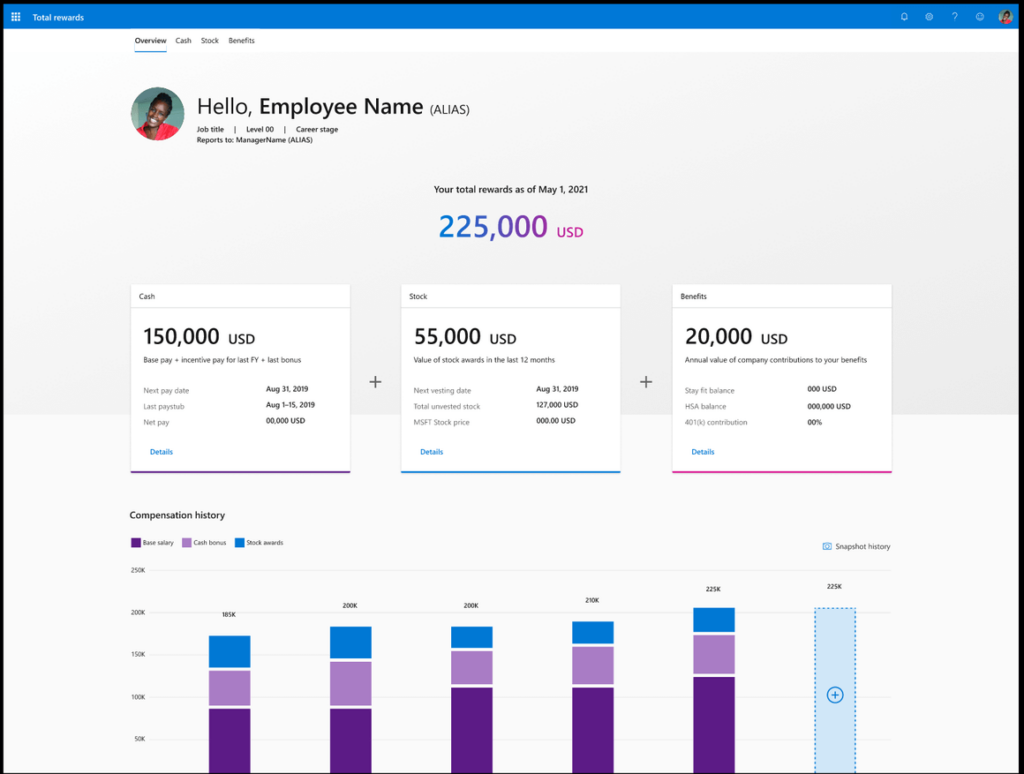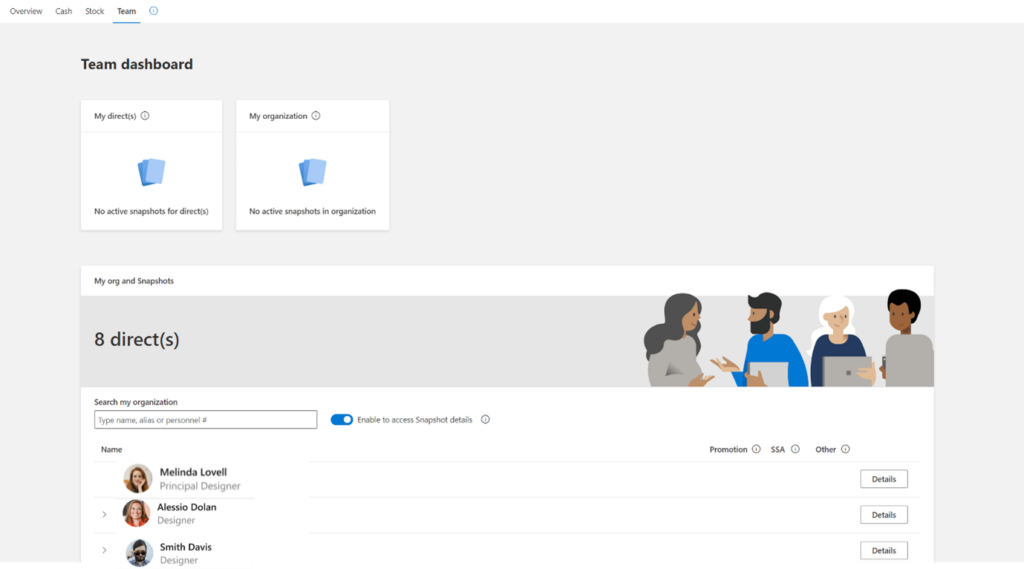 Our total rewards communications are an essential aspect of empowering employees to understand the value of Microsoft compensation and, for employees in the United States, their benefits, while reminding them of the investment that the company is making in them. When done correctly, this empowerment leads to improved engagement and retention and increased quality of new hires. At Microsoft, the Total Rewards Portal (TRP) is the mechanism by which this value proposition is communicated and shared worldwide to our 220,000-plus global employees on an individual level.
Our total rewards communications are an essential aspect of empowering employees to understand the value of Microsoft compensation and, for employees in the United States, their benefits, while reminding them of the investment that the company is making in them. When done correctly, this empowerment leads to improved engagement and retention and increased quality of new hires. At Microsoft, the Total Rewards Portal (TRP) is the mechanism by which this value proposition is communicated and shared worldwide to our 220,000-plus global employees on an individual level.
The TRP has been on a journey since it first launched in 2015, undergoing several iterations including initially being hosted by a third-party vendor. In July 2021, it was brought in-house and hosted on Microsoft Azure to have more control and flexibility to further enhance the experience. As part of this continual improvement, understanding and hearing from employees and managers about their usage and satisfaction with the tool has been critical to its overall success and the latest iteration of the portal.
“We took a three-phased approach to help us inform the most recent design, as well as guide the objectives, goals and principles for the future state of this tool,” says Nur Sheikhassan, a principal group engineering manager on the Rewards and Compensation team in Microsoft Digital Employee Experience.
Phase 1—Understanding TRP usage
The goal of phase one was to establish a baseline understanding of usage and gather insights into what was working and what wasn’t. One-on-one interviews were conducted with both employees and managers to obtain feedback. Our key findings included:
- Integration of tangible and intangible total rewards: Understanding that total compensation and benefits are often comprised of both tangible elements (such as money) and intangible elements (such as culture and work/life balance), we found it’s important to surface both in order to clearly communicate the total value of the compensation and benefits package and highlight it in a way that provides clarity rather than clutter.
- Make TRP more discoverable: The discoverability of TRP, particularly outside of rewards season, had been particularly low. Clearly and consistently branding the site and situating it within areas employees commonly use could help them discover employee tools and content related to rewards more easily.
- Optimize for the complete task flow: The tool needed to fully consider the complete flow of a potential task. We identified all the information one might be in search of to learn about their total compensation to ensure users do not feel the need to seek out additional resources on other sites and tools.
- Consider surfacing contextual data: We needed to think critically about the contextual data that is brought in to TRP and use data that will only enhance understanding the value of the Microsoft compensation and benefits packages. By focusing on common scenarios such as managers’ rewards conversations with directs, hiring, and modeling future rewards, this would help to provide a clearer path to what data should be included.
Phase 2—Develop common TRP scenarios
The next phase was designed to build on the learnings from phase one, leveraging common TRP scenarios to help understand what is working and what is not. Exploring these scenarios uncovered opportunities for consideration and started to light up themes around the need to get to overall rewards understanding faster, drive meaning through contextual data, and seamlessly connect related tools and sites. The three key themes that came out of this phase were:
- Clearly communicate value of total rewards opportunity: We wanted to display total rewards clearly, succinctly, and comprehensively, indicating relevant timeframes and breaking out cash base and bonus. We looked at utilizing data visualizations (i.e., charts) more strategically to help give a clearer view of changes and trends; otherwise, more detailed data in a table was considered to increase usability.
- Empower rewards conversations: We needed to provide more conversation starters or pointers within the tool that can help managers be prepared and have more meaningful rewards conversations with their teams.
- Optimize rewards workflows: Better access to related content and sites to enable task completion across the tools in the HR ecosystem was evaluated. Helping managers traverse the fragmented manager-tool ecosystem by providing relevant links, on-ramps, and off-ramps to related tools and information for a more seamless experience that improves workflow.
It was abundantly clear of the immediate appeal the new TRP design had on employees and managers alike. The clean, welcoming visuals and the ability to see more detail on each page in an easy-to-understand layout were all enhancements that were very well-received.
—Jennifer Hugill, principal program manager, Rewards and Compensation team, Microsoft Digital Employee Experience
Phase 3—Optimize TRP design
Building on the learnings captured from the first two phases, a redesigned user experience was developed including a high-fidelity prototype. The goal of phase three was to assess the usability of the new site and ultimately ensure that user needs and pain points were addressed with the new design.
“It was abundantly clear of the immediate appeal the new TRP design had on employees and managers alike,” says Jennifer Hugill, a principal program manager on the Rewards and Compensation team. “The clean, welcoming visuals and the ability to see more detail on each page in an easy-to-understand layout were all enhancements that were very well-received.”

Key benefits of the newly configured site include:
- Seamless task completion and delightful moments: Core tasks were easily completed, with participants noting the ability to see multiple pieces of information in a single view. Calculations that had real impact were already done for the user, and thoughtful additions like talking points and personal notes are considered both helpful and delightful.
- Continued focus on aggregation of information as a key value-add: Bringing together information from disparate systems and tools is important to users. For individual contributor (IC) views, it means showing all compensation-related information in TRP, including hourly wages for hourly workers and revenue and/or commitment-based incentives for sales employees. For managers, it’s bringing together information on direct reports into a single table.
- System “insights” that help fulfill business and user goals: Providing system-derived “insights” in both manager and IC views allows employees to spend less time connecting the dots between pieces of information and more time making decisions and taking action. For managers, it provides team insights to ensure fair compensation and talent retention. In an IC view, it showcases opportunities to take advantage of additional benefits left on the table.

“The Total Rewards Portal provides seamless access to information about my team’s comprehensive rewards and compensation, allowing me to have meaningful discussions with my employees and leadership during Connect season and beyond,” says Michelle Huenink, a Microsoft manager and global enablement leader in Customer Service and Support.
Ultimately, the goal of the TRP is to show the value of an employee’s individual rewards, while empowering rewards conversations for managers and providing a complete data set to inform decisions. Keeping these core objectives at the heart of our future enhancements enables us to continue to have a tool that provides a consistent experience that our employees will use and enjoy as part of their overall Microsoft employee experience journey.
—Nur Sheikhassan, principal group engineering manager, Rewards and Compensation, Microsoft Digital Employee Experience
Vision and Future State
Putting all the user research findings together leads to clear business objectives and user experience goals for the future state of the TRP solution. These foundational elements ensure the right principles are in place for the product team providing the guideposts to stay true to the product objectives and goals.
“Ultimately, the goal of the TRP is to show the value of an employee’s individual rewards, while empowering rewards conversations for managers and providing a complete data set to inform decisions,” Sheikhassan says. “Keeping these core objectives at the heart of our future enhancements enables us to continue to have a tool that provides a consistent experience that our employees will use and enjoy as part of their overall Microsoft employee experience journey.”

- In a competitive talent market, having a tool like the TRP really helps represent the value of Microsoft compensation and benefits and reminds employees of the company’s investment in them.
- By using multiple micro-services, we can build a better experience to represent employee compensation at various stages of an employee’s journey with Microsoft.
- Developing and using the Total Rewards Portal is providing us a strong return on our investment (ROI) over time, especially since it is now hosted on Microsoft Azure and because it was developed in-house.
- Our sensitive compensation information for 220,000-plus employees stays within the control of Microsoft while informing our employees.

- Reinventing Microsoft’s Employee Experience for a Hybrid World
- Upgrading Microsoft’s core Human Resources system with SAP SuccessFactors
- Powering hybrid work at Microsoft: A conversation with Andrew Wilson and Nathalie D’Hers
Tags: digital transformation, Employee Experience, Microsoft Azure








